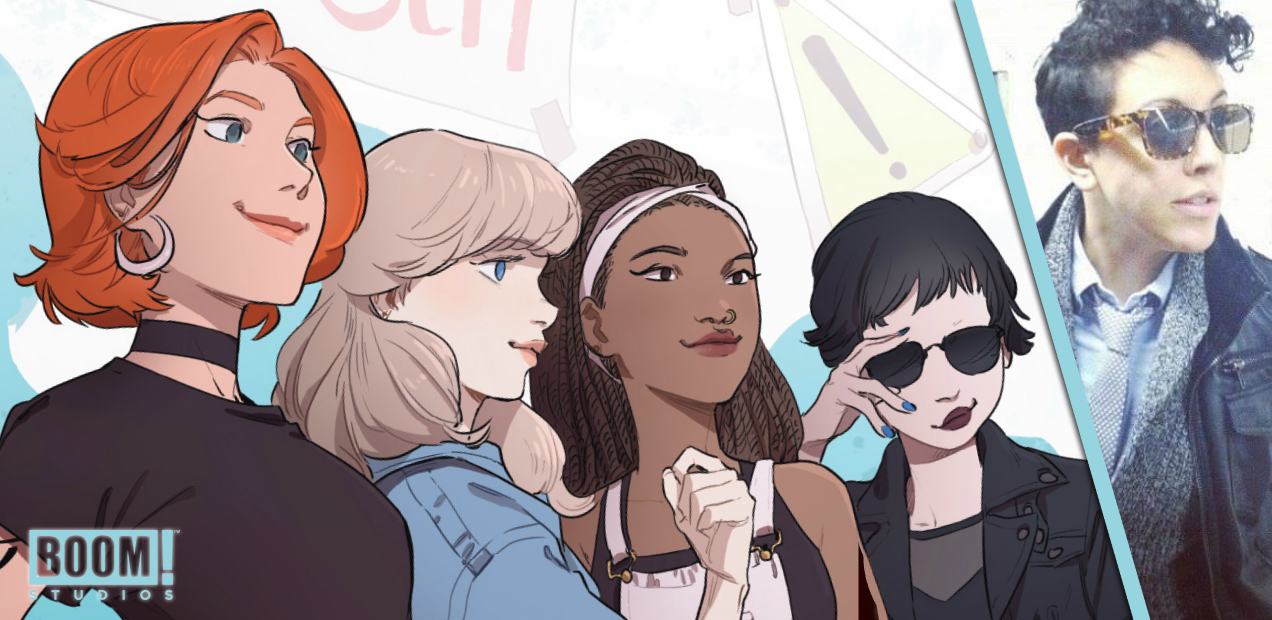By Jarrod Jones. The year is 1998. Autumn leaves skitter past the doorway of Vinyl Mayhem, New Jersey’s musical établissement d’excellence, home of choice tunes and vigilante justice. Cue that record scratch sound effect.
It’s crazy, I know. But it’s true. Counter jockeys Kennedy, Irene, Maggie, and Dolores — and soon the new kid, Chris — are united in common purpose: to kick butts as often and as thoroughly as they kick out the jams.
That’s the premise behind Hi-Fi Fight Club, an all-new BOOM! Studios/BOOM! Box series that unites film and television director Carly Usdin with artist Nina Vakueva, inker Irene Flores, and colorist Rebecca Nalty.
You likely already know Carly Usdin’s work. Her feature length film, the darkly hilarious Suicide Kale (written and starring Transparent‘s Brittani Nichols), had better ring a few bells. (Whether it does or doesn’t, you should definitely rent it anyway. Here, have a link.) She also directed this sketch for Funny or Die that nearly made me fall out of my seat. Carly Usdin knows comedy. She also knows camaraderie, something Hi-Fi Fight Club has in abundance.
“I wanted to create a well-balanced ensemble that hits all of the classic ’90s teen tropes,” Usdin says concerning Chris, Kennedy, Dolores, and the rest. “But in my own weird way.”
I had a quick chat with Carly Usdin about Hi-Fi Fight Club, the significance of the year 1998, and perhaps most importantly, record store etiquette. And to mark the occasion of Hi-Fi Fight Club‘s second issue release, we’ve supplied an exclusive four-page preview of Hi-Fi-Fight Club #2, found after the interview, courtesy of BOOM! Studios!
1. We’re really enjoying ‘Hi-Fi Fight Club’, especially its wonderful cast of characters. Each character — from Chris and her ill-advised band t-shirts to Irene and her nigh-supernatural early Twenties sophistication — has their own vivid personality, and they’re all so individualistic that when you put them together in a group shot, it’s hard not to consider them a super-team. Who are these characters to you and how did you come to realize them as individuals?
Carly Usdin: All the characters are my precious little babies and I love them all so much. Each one is a little piece of me, plus some bits of friends and people I’ve known mixed in as well. I wanted to create a well-balanced ensemble that hits all of the classic ’90s teen tropes, but in my own weird way. I’m happy you mentioned Irene here too; like, the idea of a 24-year-old being a “grown-up” role model is such a ridiculous teenager thing.
2. The story of ‘Hi-Fi Fight Club’ takes place during the autumn of 1998. In a pop culture sense, I remember it being the year of ‘Ocarina of Time’, Monica, and ‘Armageddon’. (I’m thrilled Lauren Hill got a mention in issue #1, by the way.) What is the significance of the year 1998?
CU: I was 16 in 1998. So, I wanted to tell a story that felt rooted in my own experiences, but also something that could really live on its own. I felt 1998 was a good year because it was late enough in the decade to allow access to a ton of pop cultural references, but not so late that it would require us to get into any Y2K stuff right off the bat. Also, 1998 divided by 3 is 666, which made me really happy.
3. Most of these characters are in their late teens, hovering oh-so very close to the untold potential of their Twenties. What is it about this age that makes our hearts ache reading about it?
CU: At its heart, it’s a coming-of-age story. When I look back on my late teens and early twenties, those were absolutely my most formative years. Having most of the characters in their late teens allows us to play with that strange mix of growing responsibility and parental control. Buffy always did this so well and I love getting to explore that dynamic. When you’re that age, everything feels so big and important. As you get older, you realize that a lot of it was inconsequential and silly… or maybe that’s just me!
4. It’s so natural to get caught up in the record store melodrama of ‘Hi-Fi Fight Club’ that it’s still quite a shock to realize that these kids are knuckle-cracking vigilante bruisers, fighting for the greater good. For you, where does social activism and pop culture converge?
CU: I’ve always felt that pop culture is one of the most effective ways to affect social change, which is why visibility and inclusive storytelling is so, so important. As you’ll see in future issues, there’s some history behind the fight club—they do what they do for a reason. I personally feel a responsibility, in anything I create, to push my queer, liberal agenda.
5. Everyone has experienced the colossally embarrassing “foot in mouth” moment at their local record store. What was yours?
CU: I honestly can’t remember anything I’ve done at a record store, but I definitely once wore a band’s t-shirt to their concert, and I got trampled by the crowd and was convinced I was going to die at that show. So… listen to Maggie, Chris!
‘Hi-Fi Fight Club’ #2 is in stores today.














